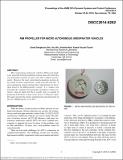| dc.contributor.author | Youcef-Toumi, Kamal | |
| dc.contributor.author | Kim, David Donghyun | |
| dc.contributor.author | Wu, You | |
| dc.contributor.author | Noel, Antoine J. | |
| dc.date.accessioned | 2019-01-15T13:29:45Z | |
| dc.date.available | 2019-01-15T13:29:45Z | |
| dc.date.issued | 2014-10 | |
| dc.identifier.isbn | 978-0-7918-4620-9 | |
| dc.identifier.uri | http://hdl.handle.net/1721.1/120039 | |
| dc.description.abstract | Micro autonomous underwater vehicles (AUVs) need smallscale, powerful and safe propulsion systems especially when they are performing missions in pipes and other confined environments. However, the most conventional propulsion systems do not satisfy all three requirements: small, powerful and safe. A micro propulsion system meeting those requirements are developed based on the RIM propeller concept. It is compact and powerful; the complete motor-propeller assembly is 33mm in diameter, 12mm in depth and 16g in weight, and it is capable of producing 0.4N thrust in static water given a 7.1W power input. The paper presents the design, manufacturing and integration of the micro RIM propeller in an AUV. | en_US |
| dc.description.sponsorship | Kuwait-MIT Center for Natural Resources and the Environment | en_US |
| dc.publisher | ASME International | en_US |
| dc.relation.isversionof | http://dx.doi.org/10.1115/DSCC2014-6282 | en_US |
| dc.rights | Article is made available in accordance with the publisher's policy and may be subject to US copyright law. Please refer to the publisher's site for terms of use. | en_US |
| dc.source | ASME | en_US |
| dc.title | RIM Propeller for Micro Autonomous Underwater Vehicles | en_US |
| dc.type | Article | en_US |
| dc.identifier.citation | Kim, David Donghyun, You Wu, Antoine Noel, and Kamal Youcef-Toumi. “RIM Propeller for Micro Autonomous Underwater Vehicles.” Volume 3: Industrial Applications; Modeling for Oil and Gas, Control and Validation, Estimation, and Control of Automotive Systems; Multi-Agent and Networked Systems; Control System Design; Physical Human-Robot Interaction; Rehabilitation Robotics; Sensing and Actuation for Control; Biomedical Systems; Time Delay Systems and Stability; Unmanned Ground and Surface Robotics; Vehicle Motion Controls; Vibration Analysis and Isolation; Vibration and Control for Energy Harvesting; Wind Energy (October 22, 2014). | en_US |
| dc.contributor.department | Massachusetts Institute of Technology. Department of Biological Engineering | en_US |
| dc.contributor.department | Massachusetts Institute of Technology. Department of Mechanical Engineering | en_US |
| dc.contributor.mitauthor | Kim, David Donghyun | |
| dc.contributor.mitauthor | Wu, You | |
| dc.contributor.mitauthor | Noel, Antoine J. | |
| dc.contributor.mitauthor | Youcef-Toumi, Kamal | |
| dc.relation.journal | Volume 3: Industrial Applications; Modeling for Oil and Gas, Control and Validation, Estimation, and Control of Automotive Systems; Multi-Agent and Networked Systems; Control System Design; Physical Human-Robot Interaction; Rehabilitation Robotics; Sensing and Actuation for Control; Biomedical Systems; Time Delay Systems and Stability; Unmanned Ground and Surface Robotics; Vehicle Motion Controls; Vibration Analysis and Isolation; Vibration and Control for Energy Harvesting; Wind Energy | en_US |
| dc.eprint.version | Final published version | en_US |
| dc.type.uri | http://purl.org/eprint/type/ConferencePaper | en_US |
| eprint.status | http://purl.org/eprint/status/NonPeerReviewed | en_US |
| dc.date.updated | 2019-01-14T20:54:32Z | |
| dspace.orderedauthors | Kim, David Donghyun; Wu, You; Noel, Antoine; Youcef-Toumi, Kamal | en_US |
| dspace.embargo.terms | N | en_US |
| dc.identifier.orcid | https://orcid.org/0000-0002-3525-9464 | |
| dc.identifier.orcid | https://orcid.org/0000-0003-0590-0481 | |
| mit.license | PUBLISHER_POLICY | en_US |
